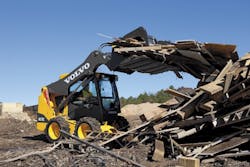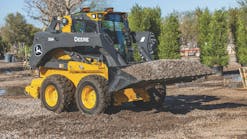The National Institute for Occupational Safety and Health (NIOSH) and the Occupational Safety and Health Administration (OSHA) consider the safe operation of the skid-steer loader (SSL) and compact track loader (CTL) an issue serious enough to be the focus of significant research. NIOSH’s Preventing Injuries and Deaths from Skid-Steer Loaders and OSHA’s Hazards Associated with Operating Skid-Steer Loaders with Bypassed and/or Improperly Maintained Safety Devices have case studies enough to give SSL and CTL operators pause when tempted to take safety shortcuts.
It’s stating the obvious, of course, but the best source of information for operating a SSL or CTL safely is the machine manufacturer’s operator/maintenance manual, as well as manuals from attachment manufacturers. These manuals frequently are an ignored resource.
We also would recommend as a source of excellent safety information, the Safety Manual series developed by the Association of Equipment Manufacturers (AEM)—particularly those titled Skid Steer Loader and Carrier Mounted Hydraulic Breaker—the latter because the SSL and CTL often are equipped with breakers. Check out AEM’s “Safety Store” at www.aem.org/SRT/Safety.
Respect machine limits
Every SSL or CTL model has a manufacturer-determined rated operating capacity (ROC), which is a percentage of its tipping load. Tipping load might be defined as the load weight that causes the rear wheels (or rear of the tracks for the CTL) to lift off the ground when the lift arms are positioned to provide maximum forward reach.
For both radial-lift-path and vertical-lift-path machines, maximum forward reach usually occurs when lift arms are parallel to the ground. Vertical-lift-path machines theoretically maintain constant reach from ground level to full lift height, but some linkages can exhibit a slight “S” pattern that could affect tipping load to some degree. The ROC for the SSL typically is 50 percent of tipping load, and for the CTL, 35 percent or 50 percent, depending on the standard applied by the manufacturer.
The practical point, here, is that operators should be cognizant that every model has its limitations. Manufactures do a good job at sizing bucket choices for a particular model in order to keep within ROC limits when working in a range of materials. But that said, such factors as a material’s moisture content and uneven ground conditions, which might shift the machine’s center of gravity, can affect a machine’s load-handling ability.
The best advice is to respect the machine’s limitations and to come down on the side of caution by moving lighter loads to test the machine’s behavior when handling unfamiliar materials, whether soil or aggregate with a bucket, construction debris with a grapple, or bulk materials with forks.
Respect safety systems
Safety features designed into the SSL and CTL typically include a roll-over-protective structure (ROPS), falling-object-protective structure (FOPS), seat belt, pull-down seat-bar restraint, and a control interlock system that prevents engine starting and/or hydraulic function unless the operator is seated.
Tampering with any of these systems is bad business. For example, modifying or removing the ROPS to work in a low-overhead situation jeopardizes the protection that the structure affords. As a further caution in low-overhead situations, never attempt to perform any routine maintenance or inspection that requires the lift arms to be raised, unless the lift arms can be positioned high enough to insert the cylinder lock.
In the OSHA publication cited above (Hazards Associated with Operating Skid-Steer Loaders with Bypassed and/or Improperly Maintained Safety Devices), machine owners and operators are cautioned to make certain that these systems are always in good repair and to never attempt defeating these systems in the interest of perceived convenience.
In one incident cited in the OSHA report, a technician was assigned to repair a leaking hydraulic cylinder. Apparently wanting to be able to engage the machine’s hydraulic controls from outside the cab during diagnosis of the problem, the technician defeated the interlock system, as the report states, “bypassing the safety bar by jamming it into the interlocks without being seated in the cab.” (The assumption is that the technician wedged an object between the lowered seat-bar restraint and the seat with enough force to both keep the bar in place and to close the pressure-sensor switch in the seat.)
Whatever method used to defeat the system, the technician started the engine and raised the bucket, the report continues, but when exiting the cab, his foot slipped and pressed the boom-down foot pedal. As the lift arms suddenly descended, he was trapped between the front linkage (perhaps the lift-arm crossbar) and the machine frame. In the process, the technician bumped a travel lever, sending the machine in reverse to collide with a forklift.
Hydraulic cautions
Since the technician above was preparing to repair a leak in the machine’s hydraulic system, be advised that hydraulic leaks are among the most dangerous hazards of machine operation and repair. Particularly with a CTL or SSL, a number of hydraulic hoses can be in close proximity to the operator—including those for lift and tilt circuits, auxiliary lines for powered attachments, and the hydraulic coupler.
As with any hydraulic hose, these “line-of-sight” hoses can rupture and spray hot oil or can develop pinhole leaks that can inject hydraulic fluid into a hand or forearm with bullet-like speed. Typically, an injection injury initially seems of little consequence, but almost always requires immediate surgery to remove damaged tissue and to relieve pressure caused by swelling.
If a machine is leaving a trail of hydraulic fluid or creating puddles when stopped, and the cause of the leak is not readily apparent, never—ever—run your hand around hoses to search for the leak, even if wearing heavy gloves. Shut the machine down and move the control levers to possibly dissipate circuit pressures, but remember that hydraulic systems can maintain pockets of high pressure for long periods. Call in a technician who knows how to handle such situations.
If you own a CTL or SSL, be advised that a number of hose manufactures—Gates, Eaton, and Parker Hannifin among them—have developed specially engineered hose-sleeve material designed to shield operators from line-of-sight hose bursts, and in some instances, pinhole leaks. These products are worth investigating in the interest of operator safety. Ordinary nylon sleeves, which are sometimes used to reduce abrasion, provide no protection against hose bursts and pinhole leaks.
While on the subject of hydraulics, remember that some machines allow the operator to adjust the response of the hydrostatic drive system and that of the implement hydraulic system. As a precaution, especially when using a machine that’s available to a number of operators, check the setting of the drive and implement systems before going to work. Could be that the system defaults to less-aggressive settings when shut down, but if not, the machine, when started by a new operator, might respond in an unexpected manner and jeopardize control.
Also, if the machine has a pattern changer for hand-lever implement controls, test controls before attempting to pick up a load. Make sure the machine is set to familiar controls.
Operating cautions
The AEM Safety Manual provides a comprehensive discussion of safe operating principles, some of which are highlighted here:
- Avoid steep slopes if at all possible, but if slopes must be negotiated, travel straight up and down with the heavy end of the machine pointed up hill.
- Do not drive across an excessively steep slope under any circumstance.
- Carry loads low; the lower the load, the more stable the machine and the better is forward visibility.
- Always check that attachments have been positively connected to the coupler. Frequently check the coupler for wear, accumulated debris, and if hydraulically actuated, for leaks.
- Remember that the SSL and CTL are one-person machines—no riders and no using an elevated bucket as a work platform.
- Clean any collected debris from beneath control pedals to keep them operating freely.
- When handling material such as large rocks or barrels, remember that lifting too high and rolling the bucket back too far can cause these objects to fall into the operator’s compartment.





